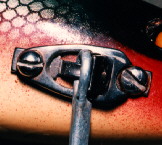

AntiqueLures |
By Dr. Michael Echols


Identifying Heddon lures can be made much easier if you know the types of hardware and the time period they were used. Other identifying features are included to help narrow the age of the lure. Due to the extensive number of variations in this area, some generalizations are made. Boxes varied with the availability as each hardware period changed, so this information is an approximation. At the bottom of the page is a sketch of the various types of hardware and the dates they were used.
- Heddon lure box examples and date sequences
- Heddon box numbers and examples of the boxes used
- Heddon lure details: gill marks, body styles, and features
- Heddon lure colors and rarity
Cup rig: One of the earliest types of hook hardware used and is typical of Heddon baits made prior to 1916-1917. There is an eye screw in the center of the cup which holds the hook. The cup was to have prevented the hook from hitting the lure body and protected the wood. There are several variations of the earliest types, but the more common type is pictured.
Props: Cup rig underwater minnows can have two types of props: unmarked (No Name On Prop) which dates them prior to 1915-1917; and Name On Prop, which dates them after 1912 when the name Heddon Dowagiac was stamped on the front prop. Heddon made a gradual change to L-rig during the 1914-1915 time range, so it is possible to find NOP lures with cup rig. Apparently they wanted to use up the last cup rig lures and placed the new marked props on the older cup rig lures.
If you want to learn more about the early hardware on Heddon minnows, see the article by Bill Sonnett called "8 years of Heddon Hardware" printed in the NFLCC magazine in 1993.
Body styles: Body shapes ranged from the earliest 1904-1906 with a high forehead and two or three belly weights, to the later slim bodies with only one belly weight. The most common is the later single belly weight.
Boxes: Early cup rig models c.1902-1904 generally came in white cardboard boxes with a picture or writing on the top of the box. As of 1904 they used both wood boxes and cardboard depending on the minnow until the 1908-1910 era. Boxes are generally thought to have been used from 1904-1910. At that time a new cardboard box was used: the blue border down leaping Bass box and then the various red border down leaping Bass boxes.
Cup Rig: there is an eye screw through the center of the cup, the rim prevents the hook from hitting the body. Other companies, like South Bend and Creek Chub used similar cups, but the props will help differentiate the Heddon. L-rig: The next hook hanger which was first cataloged in 1916. but in use in 1914-15. The hook screw has an arm for an attachment screw which comes out of the cup and on to the body. The attachment screw can be seen on the left of the photo.
- Props: Generally only Name On Prop.
- Body Shape: Early models can be slim body, but then they used what is termed the "fat body" style and later switched back to the slim body. Early lures in the 150 are made of Cedar, but later they used Gum wood which tended to flake the paint. These later lures often had the word Heddon stamped on the belly.
- Boxes: The typical box is the red border down leaping Bass box. Some earlier lures may be found in the a blue border box, but those are rare. Later models are found in the up leaping Bass box.
L-Rig: note the humped arm of the screw over the lip of the cup and a second small screw to hold the arm in place. Again, the cup keeps the hook from hitting the body. Toilet seat: This hardware is made in two pieces and the toilet seat shape gives it the name. This hardware was in use during 1927 to 1936.
- Body Style: Thin body only in underwater minnows.
- Props: Name On Prop.
- Boxes: Typically the "Brush" box with a picture of Mr. H. R. Brush on the top holding a Bass.
Toilet Seat: made of two pieces of heavy metal and linked over each other, held in place with two small screws. Two piece: Also known as "Flap" hardware was used starting in about 1936 and continued through the war until replaced by the current cheap looking surface type hardware.
- Body Style: Thin body only in underwater minnows.
- Props: Name On Prop
- Boxes: Typically the "Brush" box with a picture of Mr. Brush on the top.
Two Piece or Flap hardware: made of two heavy pieces of metal and held in place by screws. Surface Rig: The later surface rig hardware which is a flimsy one-piece surface mounted hook hanger held on with two screws and made of cheap stamped metal. Surface rig hardware is usually found on post 1950 lures.
Heddon one-piece surface type hardware typical of later lures which I do not collect since they do not fall in the pre-1940 era.
Heddon lure box examples and date sequences Heddon box numbers and examples of the boxes used
Heddon lure details: gill marks, body styles, and features
Heddon lure colors and rarity
Following is a print of various hardware from an article published in the NFLCC Gazette some years ago. Drawing credited to the "Bassman", Clyde Harbin, Sr. author of a History of Heddon, and Heddon Foot Prints. Mr. Harbin's books can be found for sale in the books and references section of this Web site.
Return to AntiqueLures homepage